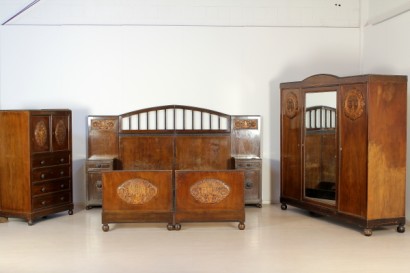Neo-Renaissance Room
Features
Style: Neo-Renaissance Revival
Origin: Italy
Main essence: Walnut
Material: Walnut Veneer
Description
Complete room consists of: bed Headboards 168x284x213 ruled by turnings, has carved panel. The headboard features side panels and molding and carved balusters with Crescent; 209x221x60 Cabinet headed by foot turned, has three doors of which mirror Central bevelled. Carved panels on the side doors. shaped Hat; 161x95x55 chest of drawers has four drawers with intalgliati knobs and two doors with carvings; Pair of nightstands 80x45x35 supported by turned feet, has a door and a drawer with turnings and carvings. Crystal top.
Product Condition:
Requires restoration and resumption of polishing.
Additional Information
Style: Neo-Renaissance Revival
Stylistic revival, of the 20th century, of the forms typical of the Renaissance style.
This is a style that re-proposes, looking at the grandeur of the past, decorative motifs and ornaments typical of the 16th century.
Masks, frames, columns carved with herms that make up architectural structures typical of Renaissance palaces, are the elements that characterize the neo-Renaissance style.
These elements will remain in the production of furnishings until the early 1900s, contaminating themselves with floral elements.
Find out more about the Neo-Renaissance with our insights:
A Milanese library between Belle Epoque and Fascism
The Austrian taste of Baroque
Gothic sculpture
Art Déco
Neoclassical architecture












































